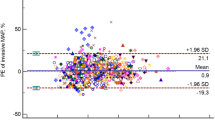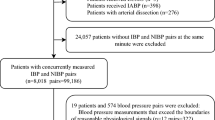Abstract
Purpose
The T-Line TL-200 (Tensys Medical, San Diego, CA, USA) is a non-invasive arterial blood pressure (BP) monitoring system allowing continuous “beat-to-beat” monitoring of systolic arterial pressure (SAP), mean arterial pressure (MAP), and diastolic arterial pressure (DAP). It provides a real-time BP waveform like that obtained using an arterial catheter. The aim of this study was to compare BP measurements obtained using the T-Line TL-200 with simultaneous invasive BP measurements using a femoral arterial catheter in unselected critically ill medical patients.
Methods
In 28 patients treated in a medical intensive care unit (ICU), BP values were simultaneously obtained using a femoral arterial catheter and the T-Line TL-200. All recorded data were included in the final analysis. For comparison of BP measurements, Bland–Altman analysis accounting for repeated measurements was performed (primary endpoint).
Results
A total of 76,826 pairs of BP measurements (each consisting of SAP, MAP, and DAP) were analyzed. For MAP, Bland–Altman analysis revealed a mean difference of +0.47 mmHg (95 % limits of agreement −16.53 to +17.46 mmHg). For SAP and DAP, the bias and 95 % limits of agreement were −9.01 mmHg (−37.47 to +19.45 mmHg) and +5.22 mmHg (−13.50 to +23.94 mmHg), respectively.
Conclusions
Non-invasive, continuous, radial BP measurement with the T-Line TL-200 is basically feasible in medical ICU patients (with a low bias for MAP compared to MAP assessed using a femoral arterial catheter). High limits of agreement (particularly of SAP and DAP) preclude the use of the device as a single source of BP information in unstable critically ill patients.

Similar content being viewed by others
References
Rivers E, Nguyen B, Havstad S, Ressler J, Muzzin A, Knoblich B, Peterson E, Tomlanovich M (2001) Early goal-directed therapy in the treatment of severe sepsis and septic shock. N Engl J Med 345:1368–1377
Kumar A, Roberts D, Wood KE, Light B, Parrillo JE, Sharma S, Suppes R, Feinstein D, Zanotti S, Taiberg L, Gurka D, Cheang M (2006) Duration of hypotension before initiation of effective antimicrobial therapy is the critical determinant of survival in human septic shock. Crit Care Med 34:1589–1596
O’Grady NP, Alexander M, Burns LA, Dellinger EP, Garland J, Heard SO, Lipsett PA, Masur H, Mermel LA, Pearson ML, Raad II, Randolph AG, Rupp ME, Saint S (2011) Guidelines for the prevention of intravascular catheter-related infections. Clin Infect Dis 52:e162–e193
Janelle GM, Gravenstein N (2006) An accuracy evaluation of the T-Line Tensymeter (continuous noninvasive blood pressure management device) versus conventional invasive radial artery monitoring in surgical patients. Anesth Analg 102:484–490
Szmuk P, Pivalizza E, Warters RD, Ezri T, Gebhard R (2008) An evaluation of the T-Line Tensymeter continuous noninvasive blood pressure device during induced hypotension. Anaesthesia 63:307–312
Dueck R, Goedje O, Clopton P (2012) Noninvasive continuous beat-to-beat radial artery pressure via TL-200 applanation tonometry. J Clin Monit Comput 26:75–83
Bland JM, Altman DG (2007) Agreement between methods of measurement with multiple observations per individual. J Biopharm Stat 17:571–582
Frezza EE, Mezghebe H (1998) Indications and complications of arterial catheter use in surgical or medical intensive care units: analysis of 4932 patients. Am Surg 64:127–131
Jeleazcov C, Krajinovic L, Munster T, Birkholz T, Fried R, Schuttler J, Fechner J (2010) Precision and accuracy of a new device (CNAPTM) for continuous non-invasive arterial pressure monitoring: assessment during general anaesthesia. Br J Anaesth 105:264–272
Hahn R, Rinosl H, Neuner M, Kettner SC (2012) Clinical validation of a continuous non-invasive haemodynamic monitor (CNAP™ 500) during general anaesthesia. Br J Anaesth 108:581–585
Ilies C, Bauer M, Berg P, Rosenberg J, Hedderich J, Bein B, Hinz J, Hanss R (2012) Investigation of the agreement of a continuous non-invasive arterial pressure device in comparison with invasive radial artery measurement. Br J Anaesth 108:202–210
Eeftinck Schattenkerk DW, van Lieshout JJ, van den Meiracker AH, Wesseling KR, Blanc S, Wieling W, van Montfrans GA, Settels JJ, Wesseling KH, Westerhof BE (2009) Nexfin noninvasive continuous blood pressure validated against Riva-Rocci/Korotkoff. Am J Hypertens 22:378–383
Nowak RM, Sen A, Garcia AJ, Wilkie H, Yang JJ, Nowak MR, Moyer ML (2011) Noninvasive continuous or intermittent blood pressure and heart rate patient monitoring in the ED. Am J Emerg Med 29:782–789
Galluccio ST, Chapman MJ, Finnis ME (2009) Femoral-radial arterial pressure gradients in critically ill patients. Crit Care Resusc 11:34–38
Dorman T, Breslow MJ, Lipsett PA, Rosenberg JM, Balser JR, Almog Y, Rosenfeld BA (1998) Radial artery pressure monitoring underestimates central arterial pressure during vasopressor therapy in critically ill surgical patients. Crit Care Med 26:1646–1649
Mignini MA, Piacentini E, Dubin A (2006) Peripheral arterial blood pressure monitoring adequately tracks central arterial blood pressure in critically ill patients: an observational study. Crit Care 10:R43
Segers P, Mahieu D, Kips J, Rietzschel E, De Buyzere M, De Bacquer D, Bekaert S, De Backer G, Gillebert T, Verdonck P, Van Bortel L (2009) Amplification of the pressure pulse in the upper limb in healthy, middle-aged men and women. Hypertension 54:414–420
Acknowledgments
Tensys Medical Inc. (San Diego, CA, USA) provided the T-Line® TL-200 device and the corresponding medical disposables (wrist splint and T-Line® sensor) as well as a computer with software for data recording. Tensys Medical Inc. was not involved in the conception of the study, collection and analysis of data, drafting of the manuscript, or in the decision to submit the manuscript for publication.
Conflicts of interest
Wolfgang Huber is member of the Medical Advisory Board of Pulsion Medical Systems (Munich, Germany), the manufacturer of the arterial catheters used for invasive blood pressure monitoring in this study. For all other authors there is no conflict of interest to disclose.
Author information
Authors and Affiliations
Corresponding author
Electronic supplementary material
Below is the link to the electronic supplementary material.
Rights and permissions
About this article
Cite this article
Saugel, B., Fassio, F., Hapfelmeier, A. et al. The T-Line TL-200 system for continuous non-invasive blood pressure measurement in medical intensive care unit patients. Intensive Care Med 38, 1471–1477 (2012). https://doi.org/10.1007/s00134-012-2617-x
Received:
Accepted:
Published:
Issue Date:
DOI: https://doi.org/10.1007/s00134-012-2617-x




